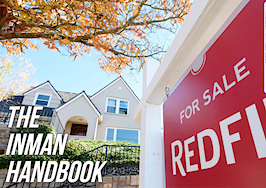Nicole Solari is a top-producing broker-owner in Northern California whose regular bimonthly column, which covers real estate marketing, selling strategies and working with clients, publishes on Tuesdays.
It happens to even the most experienced, savvy, listing agents: Your wonderful listing in a great location falls out of escrow, and then it sits on the market while newer listings around sell quickly, even after you’ve lowered the price to the point that your sellers are insisting “no more.”
Assuming your sellers aren’t turning down reasonable offers for foolish reasons, what ‘s an agent to do in such cases?
Here are nine things you can do — instead of lowering the price again — to revive a stale listing:
1. Gather as much feedback from and about prospective buyers as you can

woaiss / Shutterstock.com
We sold a property recently that was beautifully staged inside, but the stager ran out of time (and ideas) outside. Although the lot was large, it was also hilly, and most of the usable outdoor private space was hardscape divided into multiple smallish sections.
The consistent feedback from agents and open house visitors alike was, “The house is gorgeous, but the yard seems is too small!” We hired a very inventive stager and handed her the problem.
Once she worked her magic, the feedback turned completely around. Visitors consistently said, “Oh, it’s so nice out here, I don’t want to come back inside.”
The house sold shortly after the revitalized exterior staging went in.
So, go back to your notes from early open houses. Were there one or two consistent things buyers mentioned unfavorably?
Next, reach out to all the agents who have shown the property. Be up front with them about needing feedback. Not everyone will reply, but enough will to give you a feel for what exactly the sticking points were with previous prospective buyers.
With that feedback in mind, you can do the following things to make the property like a “new” listing again.
2. Tour your listing to experience it as a buyer does

wavebreakmedia / Shutterstock.com
How does the listing look and smell? What’s the first thing buyers notice when they come up the walk, open the front door and move from room to room?
If the yard is barren and the home is jammed with furniture and belongings, the sink is piled with reeking dishes, individual rooms have only narrow paths through the clutter and the bed is surrounded by so much stuff it looks like you’d have to pole vault in and out of it, your problem is too much stuff.
And in most cases, too much stuff also stinks. These sorts of properties are nearly impossible to sell unless they’re priced way below market because buyers simply cannot visualize cluttered spaces when they’re empty.
These can be hard conversations to have with sellers, but it might be easier to convince them that changes need to be made if you take them through comparable properties that are clutter free or staged (or whatever the specific issues you have to deal with are), so they can experience the difference between their property and others first hand.
When the clutter is gone and the curb appeal enhanced, make sure your sellers keep it in showing condition every day. You already know they have a tendency to live in a mess. You can’t let them fall back into habits that might have already killed their sale who knows how many times.
Take photos of how each room is supposed to look, if you must, and hand them their “cheat sheet” to set things right before they leave (with children and animals in tow) prior to each showing.
3. Take a fresh look at your marketing

Credit: Helloquence on Unsplash
Once the property is in good showing condition (inside and out), ask yourself if your marketing is effectively targeting the most likely buyers?
If, for example, your listing is a one-bedroom condo and your introductory description emphasizes its family-friendly location, schools and nearby parks and playgrounds, you are speaking to families and not to the professional singles or couples the property would most likely appeal to.
That busy group puts a premium on a property’s being in move-in condition: having popular finishes, furnishings, and colors, being low maintenance and located close to commute routes or to downtown technology or financial centers.
If it takes writing out a detailed description of what your best target market is and jotting down everything that appeals to those buyers, then start making a list.
With key buying criteria in hand, you can reposition your listing, starting with the introductory description. If writing isn’t your strong suit, hire a freelance copywriter, or get help from marketing-oriented friends or relatives.
It would also benefit you to pull the latest comps, both for your own reference and to convince sellers if your research and consultation with your stagers indicates changes need to be made.
Nobody likes to spend money before a sale, though they must. But, if you can figure out how they can put improvements on a credit card, that makes changes easier to bear because the bill will come due, hopefully, after closing.
4. Have new professional photography done — even if you’re not repositioning the property

Photo credit: Andresr / Shutterstock.com
New photographs should feature different angles and lighting — inside and out — and highlight different features you know your target buyers will respond to. New professional photos can give an old listing vibrant new life.
This is especially true if you’re one of those agents who takes six shots of a new listing with your camera phone (and you appear in the bathroom mirror). Seriously, we cannot believe there are still agents who do that!
Professional photography is a must, now that everyone is window shopping online and deciding — based on the photographs — which properties to visit and which to avoid.
5. Stage or restage the property before the new photographs are taken

Photo by NeONBRAND on Unsplash
If your seller balked at staging and you gave in, staging a property to appeal to your target market is usually cheaper than the next price cut would be. If the feedback you’ve collected tells you the existing staging isn’t working, then change stagers or ask for a restage to better fit your target buyer.
Ask your stager if any room colors need to be altered before the property is restaged. Most stagers will happily work with you and the seller to make the home appeal more precisely to likely new buyers.
It’s sellers who make those conversations difficult because they don’t understand that their “awesome decorating skills” are not the same as a stager’s ability to merchandise a property for maximum sales appeal.
It’s your job, as the agent, to convince them staging is the quickest way to sell a property at the absolute maximum price because most buyers don’t have much ability to visualize anything other than what’s right in front of them.
6. Take the listing off the market while the facelift is going on

Photo by Kobu Agency on Unsplash
Depending on your MLS rules, you could expire the listing out and relist it when the facelift is done or take it off the market temporarily. But, by whatever means, you want the old listing gone, so a “new” or BOM (back on market) listing will pop up on every agent’s daily hot sheet as soon as the property refresh is done and the home is back on the market.
While the listing is down, you should add a note in your confidential remarks stating that the home is being refreshed and will be back on the market soon, so agents don’t besiege your sellers for the listing, and those who have the right buyer know to reach out to you for updates.
You don’t need to pull your sign, but adding a “coming soon” rider to it might be worthwhile.
7. Keep the listing active on social media

Your Design / Shutterstock.com
Once the property goes back on the MLS, keep it in front of prospects on social media and elsewhere.
We’re all very social media-oriented these days. But in many smaller towns, the local paper is still where a lot of buyers — particularly those over 40 — rely on their newspaper’s Sunday Open House listings and map. So use conventional media wisely along with being everywhere online.
Although many MLS listings auto-populate popular home search sites — like realtor.com, Zillow, Trulia, Redfin, Homes.com, etc. — you might also have the option of going into your listing pages on those sites and crafting more extensive descriptions or highlighting neighborhood features.
It’s worthwhile to go that extra mile to make your revitalized listings truly stand out on those sites as well as on the MLS. Again, if you need writing or photographic help, it is available on a freelance basis.
8. Engage local residents, especially neighbors, in the sales effort

Andrew Yahin / Shutterstock
Send neighborhood invitations or area-wide postcards prior to public or neighbors-only open houses for the newly revived listing.
Install a sign rider that cries “Open Sunday,” create open house posts, buy low cost “boosts” on popular sites such as Facebook (especially if you’re targeting younger or entry-level buyers) and target the reach to local residents and buyers.
Instagram is useful for real-time posts about your open houses beginning or nearing their closing hour. Make sure both sites are in “public” mode before you share photos and posts.
9. Offer buyer’s agent incentives

Photo credit: Sergei Aleshin | Shutterstock.com
If all else fails, offer a bonus or other incentives to the buyer’s agent who writes a successful offer by a set deadline.
You will probably have to pay for it out of your own commission, but at some point, it might be worth it to you. Offering the right incentive (and cash remains king here too) is guaranteed to get you more showings by agents with good to marginal buyers.
And one of them might take a shine to this “new” property and decide it is the home they’ve been looking for all along. Just keep your expectations realistic: The incentive doesn’t make a sale, it gets the property extra showings. The property has to sell itself by looking its best at all times.
If you do all these things and the house still doesn’t attract prospective buyers, either your marketing has gone astray or the price is still too high for the condition and location.
But these nine steps should be taken before you ask for a price reduction — especially if sellers have reduced their price as much as they can.
Most of these measures are inexpensive and not terribly time-consuming and taking them will impress your seller with your diligence. So, why not give them a try?
They’ve worked for us.
Nicole Solari is owner and managing broker of The Solari Group in Solano and Napa Counties in Northern California. Nicole runs one of the highest producing brokerages in all of Northern California.







